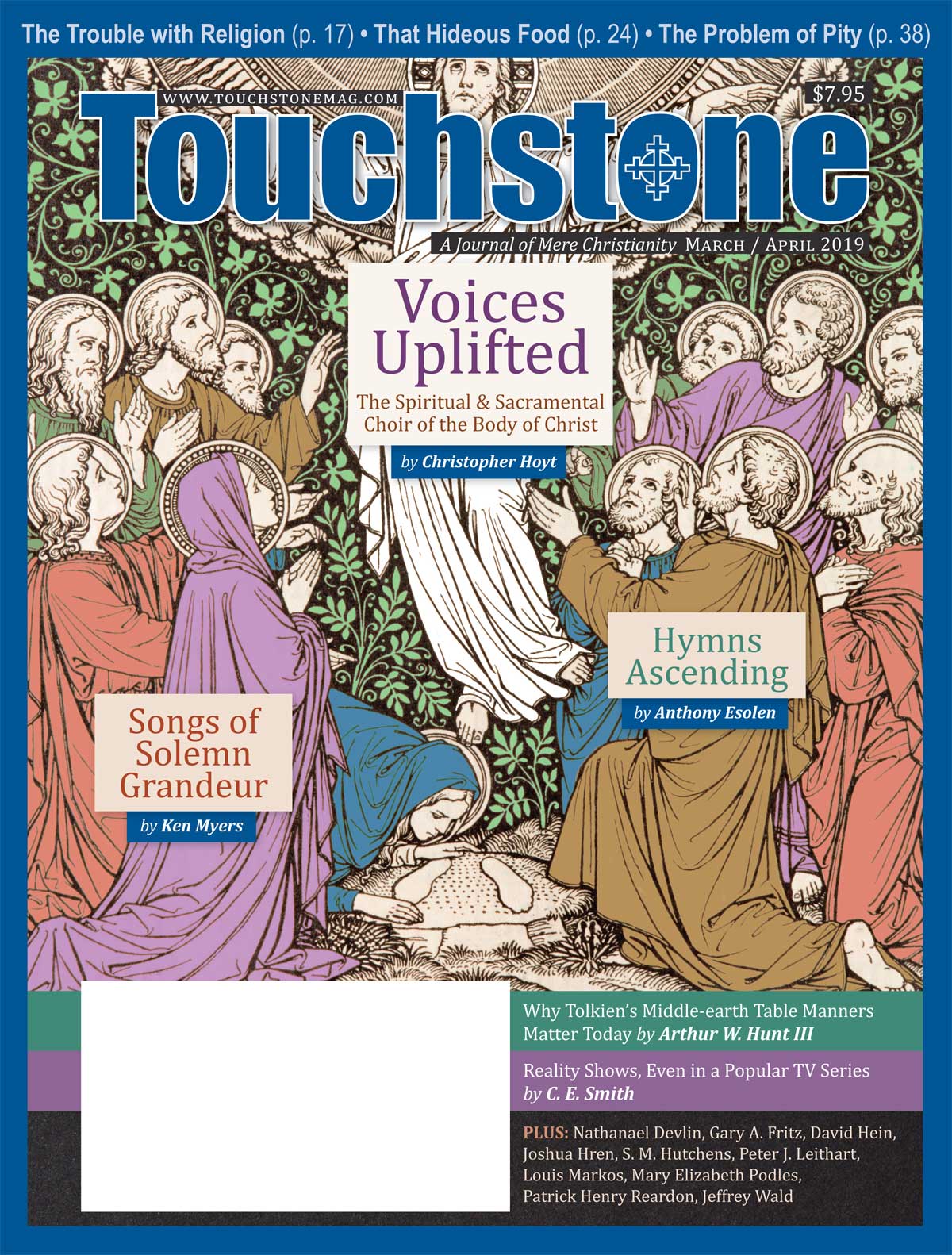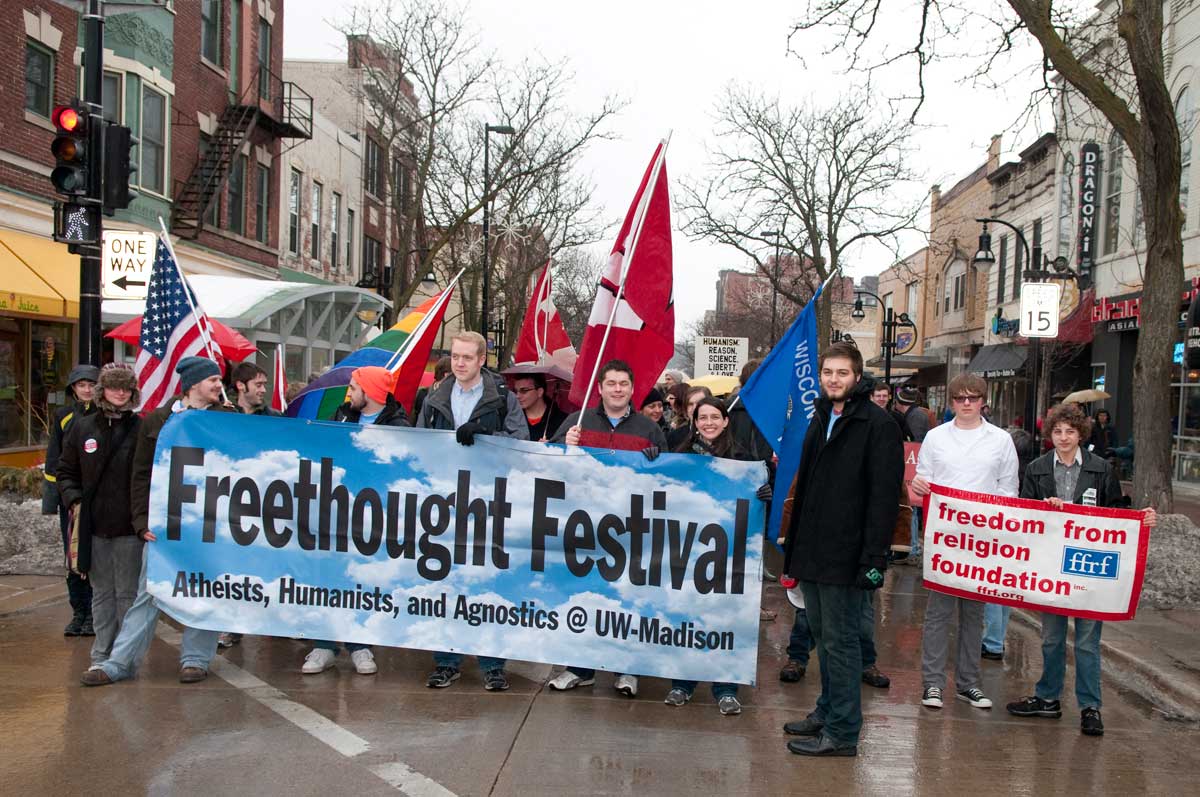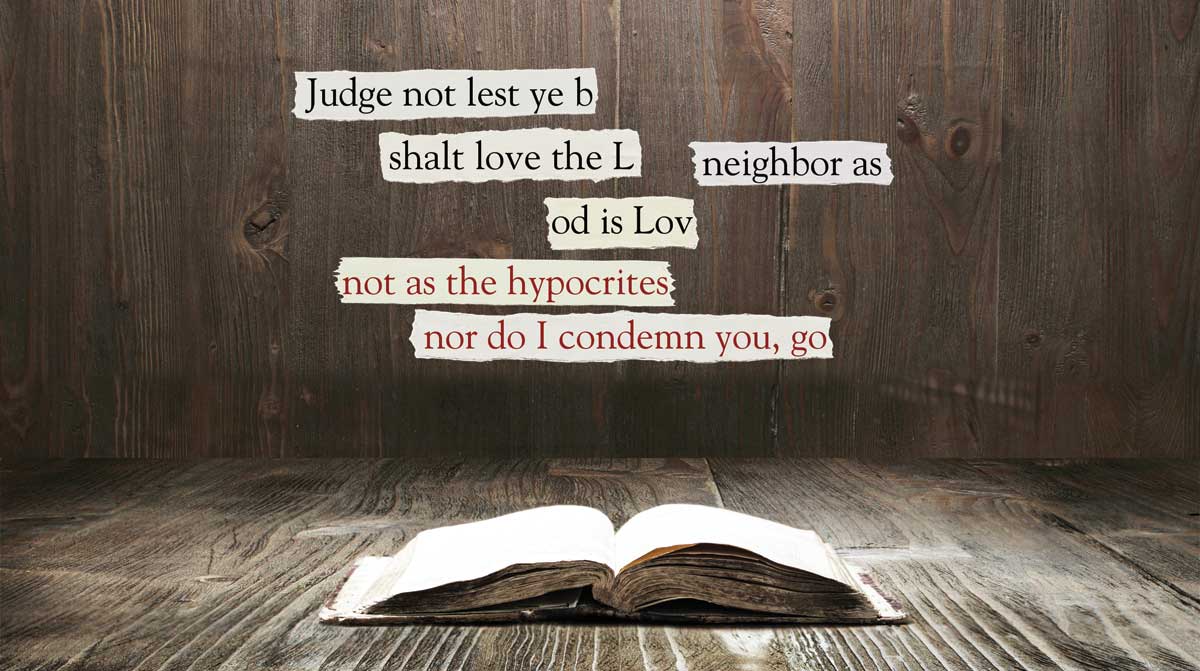Feature
The Mimetic Bachelor
Reality Shows, Even in a Popular TV Series
by C. E. Smith
On TV's wildly popular reality show The Bachelor, twenty-five women compete for the title character's hand in marriage while each week he pares down the number of potential wives in a ceremonial distribution of roses. Its sister program, The Bachelorette, replicates the narrative format and dating rituals but with the sex dynamic reversed, a difference that, if nothing else, increases the likelihood of fistfights. The confined process of elimination resembles a locked-room mystery but with polyamory rather than homicide as the focus. It is a crass spectacle worthy of Kierkegaard's observation that "what the world honors and loves under the name of love is group-selfishness."
I'm sufficiently inured to primetime vulgarity that I can neither recommend The Bachelor nor continue to blame my wife for making me watch it. But my initial disgust with the show has given way to amused tolerance and even curiosity, not least because of its remarkable compatibility with the biblical anthropology of French theorist René Girard.
Girard's central idea is that all human desire is imitative, or mimetic. Mimetic desire is responsible for the inflation of any object's value beyond its intrinsic worth, as we might see in fashion trends, exorbitant art sales, or obsessions with brand names or celebrities. Mimetic desire explains the problem of "keeping up with the Joneses" and the tendency of small children to break into sudden fights over previously neglected toys. It can also be said to account for The Bachelor, not just its enormous popularity but also its very premise—the irrational desire of twenty-five women for the same man.
Mimetic desire leads to conflict when two or more individuals lay claim to the same object and, through imitation, reinforce one another's desire for it in a cycle of escalating intensity. Among the earliest human communities, which lacked any kind of legal or institutional restraints, an inevitable crisis such as a food shortage or plague had the potential for a catastrophic "war of all against all." No such community could have survived its own violence without channeling that violence onto a single victim in a spontaneous process Girard calls the scapegoat mechanism. The war of all against all had to become a war of all against one.
For the scapegoat mechanism to occur, mimetic rivals must become so consumed by hatred for each other as to lose sight of their original object of desire. Acquisitive mimesis, which is focused on the desired object, devolves into conflictual mimesis, or mimetic hatred. As hatred grows, it suppresses any differences in status or personality that might have existed between the antagonists. They become interchangeable doubles, each resembling not just the other but also the participants of neighboring rivalries. This allows for the substitution of enemies and formation of alliances.
As conflictual mimesis spreads like a contagion, individuals attempt to differentiate themselves by means of increasingly flamboyant accusations. A particularly egregious crime, whether true or not, has the potential to attract the condemnation of others, so participants in unrelated conflicts might find common cause in shared disdain. A coalition gains mimetic force with each new member—its appeal being based on the number of participants and the moral offense of its target—and rivalries coalesce in self-perpetuating fashion until the community is united or nearly united against a single enemy. The hapless figure who emerges as the scapegoat does so either at random or as the result of some distinguishing trait, such as a limp, left-handedness, foreign origin, or a lack of any close relative to defend him against outrageous accusations.
In every season of The Bachelor, a group of contestants forms a coalition against a single rival, a woman who initially sets herself apart by monopolizing the bachelor's time in private conversation and depriving others of opportunities to prove themselves worthy of roses. Her audacity arouses suspicions of guile and the inevitable accusation of being on the show "for the wrong reasons," perhaps for the advancement of her acting career rather than love and marriage.
The other contestants hesitate at first to revile her in the presence of the bachelor, but it isn't long before one of them decides to throw the first stone by divulging the reasons for their collective rancor. Never does the bachelor reward outright slander, even if he's proven his gullibility and poor judgment by giving roses to someone so objectionable, but in the mind of the slanderer, hatred of the rival outweighs her desire for the bachelor. Conflictual mimesis has replaced acquisitive mimesis. She is now likely to be eliminated even sooner than the scapegoat, but she has no excuse after having seen the same mistake played out in every previous iteration of the show.
The Basis of Polytheistic Religion
The Bachelor sustains conflict by means of an artificial shortage of sexual partners. Similar shortages in the prehistoric world catalyzed innumerable mimetic crises and collective murders. In the aftermath of a scapegoating event, the primitive community responsible for it experienced profound tranquility as former rivals reconciled under a common cause. The radical transformation from chaos to peace struck the people as so abrupt and so powerful that only a supernatural explanation would suffice. The supposed malefactor whose putative crimes were the source of all the community's ills now, in immediate hindsight, became the opposite, a deity responsible for the community's unity and peace. Humans didn't invent their gods, Girard says in I See Satan Fall Like Lightning: they deified their victims.
Here we see the basis of all polytheistic religion. The tranquility brought about by spontaneous acts of collective murder compelled prehistoric communities to enshrine their victims as gods. This is why all of the world's myths, regardless of geographical origin, contain veiled references to the scapegoat mechanism. An example is Oedipus, whose expulsion from Thebes resolves the plague brought about by his incest and parricide. The story refers to actual events: some primitive community lynched one of its members after blaming him for a plague. In a myth from the Pacific Tikopia, the god Tikaru, depicted as a trickster and a foreigner, fakes a limp in order to steal from his fellow deities, and then flies to safety when they pursue him into the hills. The real victim here was probably a foreigner with a distinguishing limp, forced by the community over an escarpment or some rocky height.
Prehistoric groups that failed to resolve their mimetic crises by means of the scapegoat mechanism extinguished themselves in mêlées of reciprocal homicide. Communities that survived did so first by spontaneously murdering a randomly chosen individual, and later by periodically reenacting that murder in the form of ritual sacrifice. Sacred bloodshed neutralized violent impulses while approximating the transcendent reconciliation of that first murder.
Another way early communities protected themselves against the destructive power of acquisitive mimesis was to institute prohibitions. Girard speaks of the anti-mimetic character of all archaic prohibitions. Mimetic theory sheds light on those laws which might otherwise seem nonsensical or arbitrary, such as the prohibition of identical twins and the sacrifice of one or both in infancy. Twins would have suggested the leveling effects of mimetic rivalry, the loss of differentiation. The fear of interchangeability also explains the frequent prohibition of images and reflections, and in later traditional societies the mistrust of the theater and actors.
Sacrificial rituals and their associated prohibitions represented the earliest forms of social organization. Out of sacrifice grew a need for stewards of the ritual and the implements necessary for its performance. Sacred rites were connected to rites of passage and rites of education. A social network was necessary to enforce prohibitions. If there were a period of delay between the designation of a sacrificial victim and the actual sacrifice, the intended victim became a figure of veneration, thus laying the groundwork for future structures of sacred kingship. Social hierarchies and caste systems evolved as barriers to prevent mimetic models from becoming rivals. Spontaneous collective murder gave birth to religion and religion gave birth to civilization. Girard borrows from Freud to describe the original scapegoating event as a founding murder.
Rituals are an essential feature of The Bachelor. The most obvious example is the so-called rose ceremony, in which the contestants gather by candlelight before the bachelor, all waiting to be either banished or given a rose. The expulsions are suggestive of ritual sacrifice, with red roses to stand for blood and the priestly Chris Harrison, the show's host, to oversee the procedure and utter the incantation: "Ladies, Hercules, it's the final rose tonight." After tawdry Jacuzzis and mud wrestling, the decorous formality of the rose ceremony suggests a belief that in the absence of religion a caricature of it might at least serve as a reminder of transcendence.
Repudiation of Mimetic Desire
All paths in mimetic theory lead back to the question of religion. Contestants on The Bachelor might be surprised to recognize in the pages of the Bible distant analogues of their televised shenanigans. Girard's theories grew out of his work in literature and primitive mythology. He found the same mythic elements in the Judeo-Christian Scriptures, but there were subtle yet striking differences, unique narrative features distinguishing the Bible from all the rest of the world's ancient literature. The implications of those differences compelled Girard to embrace the Christian faith.
Starting in Genesis we encounter the recurrent themes of mimetic rivalry and the scapegoat mechanism. Adam's desire for the apple is modeled on the same desire in Eve, who models her desire on the serpent. Satan, the arch model, is the great imitator who wants to be imitated. He personifies mimetic desire, presenting himself as a model to be imitated before becoming a stumbling block for the imitator. Cain produces the first civilization through a founding murder; Jacob overcomes his mimetic rival by donning sacrificial animal skins; and Joseph becomes the scapegoat of his brothers. "In every one of the great scenes of Genesis and Exodus there exists a theme or quasi-theme of the founding murder or expulsion," writes Girard in Things Hidden Since the Foundation of the World.
A feature of the Old Testament that sets it apart from all of the mythologies of the ancient world is its consistent refusal to cast the victim as guilty or his persecutors as innocent. The Mosaic law makes special accommodations for foreigners and widows and orphans, the members of the community most susceptible to becoming scapegoats, and the Psalms repeatedly give voice to victims of unjust oppression: "Those who hate me without reason outnumber the hairs on my head" (69:4). The Decalogue condemns mimetic rivalry and its violent potential. "Thou shalt not covet . . . anything that belongs to another" (Ex. 20:17). The final commandment restricts acquisitive mimesis, the root cause of the crimes forbidden in the preceding commandments: murder, theft, adultery, and bearing false witness. The Hebrew word for "covet" is the same word used in Genesis to describe Eve's desire for the apple. The prohibition of covetousness might be said also to encompass the first section of the Decalogue, since all pagan deities have their origin in mimetic rivalry.
The New Testament also privileges the tenth commandment. When the rich young ruler asks how to inherit eternal life, Jesus says: "No one is good except God alone. You know the commandments: 'Do not commit adultery, do not murder, do not steal, do not give false testimony, honor your father and mother.'" Here we see first an encapsulation of the religious portion of the Decalogue—"No one is good except God alone"—followed by an enumeration of the moral commandments, but with the conspicuous omission of covetousness. The rich man claims to have obeyed the law, but Jesus says: "You still lack one thing. Sell everything you have and give to the poor, and you will have treasure in heaven" (Luke 18:18–22). What Jesus commands here is radical obedience to the tenth commandment, a complete repudiation of mimetic desire.
In Romans, Paul writes, "For I would not have known what coveting really was if the law had not said, 'You shall not covet.' But sin, seizing the opportunity afforded by the commandment, produced in me every kind of coveting" (7:7–8). This passage illustrates the twofold purpose of the law—to define sin, and to reveal the sinner's sinfulness—but it goes on to describe its paradoxical effect of inflaming the very behavior it forbids. This can be seen as a mimetic phenomenon: the prohibition induces a mimetic urge by creating an imaginary model of transgression. Paul's designation of covetousness as a metonym for the entire law aligns with Girard's view of it as the ultimate sin, the sin behind all other sins.
Inversion of the Scapegoat Mechanism
Jesus' very first words in the book of John reflect the central importance of desire: "What do you want?" (1:38). The Sermon on the Mount intensifies the anti-mimetic features of Mosaic law, commanding radical generosity on top of the prohibition of covetousness, and non-retaliation on top of the prohibition against murder. Jesus' multiplication of loaves and fishes suggests an inversion of the scapegoat mechanism. He faces a crowd in the midst of a food shortage, but miraculously averts the crisis. The Gospels repeatedly locate Jesus in opposition to crowds. We see him confront the mob determined to stone an adulteress: "Let him who is without sin cast the first stone" (John 8:7). Early in Luke, the people of Nazareth "got up and drove him out of town, and took him to the brow of the hill on which the town was built, in order to throw him down the cliff" (Luke 4:28–29). It is the same type of murder implied by the myth of Tikaru, the forcing of a victim off a cliff or high place. The offhand geographical detail, "the hill on which the town was built," suggests a connection between mob violence and the founding of civilization.
Of course the Passion is the ultimate example of the scapegoat mechanism. The trial, crowd, mock honors, and killing outside the city—these are all features that can be found in mythology. The innocence of Jesus is the key difference. "They hated me without cause," he says, echoing Psalm 35 (John 15:25). Those who welcomed him into Jerusalem a week earlier now demand his execution. As we see in Peter's threefold denial, even Jesus' allies and disciples succumb to the mimetic power of the mob. Luke's Gospel even includes a reference to the reconciliatory effect of collective violence: "That day Pilate and Herod became friends—before this they had been enemies" (23:12).
Jesus' "They know not what they do" is a literal definition of the persecutory unconscious behind the scapegoat mechanism (Luke 23:34). Girard calls it a mechanism because of its automatic nature, and because of the requisite ignorance at the heart of it: the crowd must be convinced of its victim's guilt in order for the mechanism to serve its cathartic purpose. In myth, the mob is always innocent, the victim always guilty, but in the Bible, the victim is never as guilty as his persecutors believe.
The Gospels disclose the scapegoat mechanism in a way no myth ever could. What makes such a disclosure possible is the existence of a dissenting minority that arises within days of the Crucifixion. It is an argument for the truth of the Resurrection that Peter and the disciples would reverse course so soon after yielding to the mob, for only by supernatural means could they withstand the power that up to that moment had both poisoned and sustained every civilization since the foundation of the world. If the scapegoat mechanism only works to avert violence when its participants genuinely believe in the guilt of their victim, the dissemination of the Gospels enfeebled it by exposing the truth at the heart of it.
In Acts 14, the people of Lystra mistake Paul and Barnabas for gods—Paul for Hermes, and Barnabas for Zeus. The apostles, of course, recoil at the prospect of ceremonial adulation, which prompts their would-be worshipers to stone Paul and leave him for dead outside the city. It is a reversal of the usual mimetic sequence: the deification in this case precedes the act of collective violence, and the episode culminates with Paul's bold reentry into the city, no doubt limping from his wounds. This narrative reversal illustrates the power of the gospel to dismantle mythic forms and reveal their underlying cruelty and injustice.
The Secular Compassion for Victims
An argument for fair treatment based on innate human dignity would have seemed absurd to the average denizen of the Roman Empire before the Christian era. In I See Satan Fall Like Lightning, Girard writes, "No one and no tradition before the Bible were capable of calling into question the guilt of victims whom their communities unanimously condemned." But with the spread of Christianity came a new awareness of victimization, oppression, and persecution. The ongoing Christian revelation over the last two thousand years has gradually produced an era of compassion,
an era in which sympathy for victims has become the supreme virtue.
A recurring motif on The Bachelor is the desire of contestants to enhance their status by presenting themselves as victims. As soon as one of them sprains an ankle, the bachelor's compassion accelerates a secondary mimetic contagion, prompting contestants to jockey for victimhood by confessing personal hardships such as divorces, cancer, family dysfunction, or the deaths of friends or loved ones. Any hint of insincerity in such a complaint marks the contestant as a potential scapegoat.
The liberal democracies of the West have assimilated Christian morality without crediting the source. And the secular compassion that privileges and protects victims has given rise to a new sort of persecution: the victimization of anyone perceived as a victimizer. It is a pattern analogous to Paul's experience with covetousness, whereby moral education inflames immoral behavior. Eminent biologist Richard Dawkins, in The God Delusion, writes: "The God of the Old Testament is arguably the most unpleasant character in all of fiction: jealous and proud of it; a petty, unjust, unforgiving control freak; a vindictive, bloodthirsty ethnic cleanser; a misogynistic, homophobic, racist, infanticidal, genocidal, filicidal, pestilential, megalomaniacal, sadomasochistic, capriciously malevolent bully." Each item in this string of epithets appeals to the concern for victims, a moral absolute paganized to suit a relativist mindset. Before the dissemination of the Judeo-Christian Scriptures, the immorality of bullying, racism, or even genocide was hardly self-evident. Dawkins's moral condemnation of the Bible relies entirely on biblical morality.
Without a biblical foundation, compassion for victims becomes susceptible to arbitrary and politically motivated definitions of victimhood. Flannery O'Connor warned that "in the absence of faith, we govern by tenderness. And tenderness leads to the gas chambers." If she were alive today, O'Connor might have said it leads to the abortion clinics as well. There is no victim more innocent than a fetus, but political forces have prioritized the victimhood of those burdened with unwanted pregnancy. People need their scapegoats, and if kindness reigns supreme without a moral framework to support it, anyone deemed unkind is susceptible to scapegoating even when he speaks the truth.
The secular compassion for victims cannot be relied upon to protect us from our own violence. Modern culture offers no cathartic outlet for the resolution of mimetic crises. Humans possess increasingly sophisticated weapons, ever more powerful capabilities of murder, but at the same time Christianity has incapacitated history's most effective safeguard against mass violence. In this way, Girard's anthropological recapitulation of the doctrines of original sin and atonement also allows for an elucidation of the apocalypse. The Gospel of Matthew anticipates the problem faced by a Christian culture not Christian enough: "I did not come to bring peace, but a sword" (10:34).
For Girard, the law, prophets, and Gospels chronicle a gradual rejection of violent sacrifice. "You do not delight in sacrifice, or I would bring it; you do not take pleasure in burnt offerings" (Psalm 51:16). Along these lines, the judgment of Solomon can be seen as a history of religion in microcosm. When two mothers, one of whose babies dies, fall into mimetic rivalry over the surviving infant, Solomon proposes lopping it in half with a sword. The true mother saves the child's life by relinquishing her maternal claim. Here we see the two possible resolutions of mimetic crisis—either the bloodshed behind all primitive religion or the selfless nonviolence of Christianity. Girard's biblical anthropology describes a transition from blood sacrifice to self-sacrifice.
"Outsider" Contestants
Most seasons of The Bachelor have included a single mother sacrificing time with her child in order to participate. The show always finds drama in the mother's task of revealing this information to the bachelor, who must then decide if he's ready to play the role of stepfather as well as husband. If the single mother survives enough rose ceremonies, the child might be featured in a staged introduction to the bachelor, followed by shots of the three of them awkwardly frolicking on a playground or beach. The other contestants, like those of us watching at home, tend to vacillate between sympathy for the mother's separation from her child and repugnance that she would have agreed to such a separation in the first place.
Another type of visitor from the outside world is the contestant from a prior season of The Bachelor who for one reason or another wants to marry the current star or at least use the opportunity to advance her own celebrity status. This always creates conflict, because it entails a malignant degeneration of mimesis.
When mimesis is externally mediated, the imitator exists at such a remove from her model as to preclude the possibility of rivalry. To make the shortage of potential husbands convincing enough to generate mimetic rivalry, The Bachelor has to construct an artificial yet rigidly defined zone of internal mediation.The interloper represents for the native contestants not just a reversal of gains from the last rose ceremony, but also a disorienting violation of an established social order. Her "foreignness" is the distinguishing feature that renders her most vulnerable to scapegoating, not least because it could make her more interesting in the eyes of the bachelor. She inevitably provokes from the other contestants such hostility as to permit their reconciliation with any pre-existing scapegoat.
Immanent Marriage, Transcendent Fame
It might be worth asking why anyone would aspire to star in The Bachelor or Bachelorette. The dubious prospect of fame and fortune comes with a cost of profound emotional turmoil. One can only imagine the stress of having to terminate multiple relationships while under the scrutiny of TV cameras. Each season portrays in its central character an ever-intensifying problem of indecision, a problem that can be attributed, at least in part, to the absence of rivals. Without other men against whom to compete, there is little beyond social affinity, alcohol, and simple lust to inform the bachelor's desire for one woman over another. The absence of rivalry has the inevitable effect of devaluing an object of desire. This might be one of the reasons the marital plans of so many Bachelor contestants fall apart "after the final rose."
A notable exception is 2013 star Sean Lowe, a Christian who withstood an avalanche of ridicule for his commitment to sexual abstinence before marriage. His status as "the virgin Bachelor" seemed to remain intact after he spent the night with each of his four top choices in the so-called Fantasy Suite. The media portrayed him as a cultural oddity despite the orthodoxy of his position. And yet, out of twenty-two seasons of The Bachelor, his is the only one to have produced an actual marriage. The 2009 and 2018 stars might claim a sort of qualified success, each having broken off his engagement in the post-season only to marry the runner-up.
The Bachelorette can boast slightly better odds, three marriages in fourteen seasons, but in either case the numbers would seem to belie the matrimonial agenda. The prospect of marriage lends a veneer of respectability to what otherwise might be described as an elaborately ritualized bacchanalia. The same might be said of our dissipated culture, which obsesses over the right to marriage while at the same time stripping it of any connection to religion or childbirth.
No doubt there is more than marriage at stake for Bachelor contestants: roses have the added benefit of conferring screen time. The longer a contestant remains in play, the closer she comes to becoming something of a celebrity, or at least a quasi-celebrity eligible for Dancing with the Stars. But the ultimate achievement for a Bachelor contestant, even more than marriage to the bachelor, is to be anointed star of The Bachelorette. The way each of these nearly identical shows supplies human capital for the other is reminiscent of biological self-replication, a virus perfectly suited to its cultural environment even as it generates less adaptable mutants like The Bachelor Pad, Bachelor in Paradise, and The Bachelor Winter Games.
Each episode of The Bachelor concludes with a victim, the latest rejected candidate, whose tears of anguish, televised in detail, serve through mimetic effects to enhance the bachelor's desirability and consolidate the sympathies of fellow contestants and "Bachelor-nation" viewers. Romantic bonds grow stronger over the course of a season, so with each passing episode the break-ups become increasingly difficult for all involved. The typical victim, filmed in the backseat of a departing SUV, offers a harrowing lamentation punctuated by censorious bleeps. Much of the behavior on The Bachelor has the air of contrivance—the contestants are often aspiring actors—but in these backseat moments at the end of each episode, there is never any question of the rejected woman's sincerity.
A reason for the show's enormous success is the guarantee of genuine suffering. Viewers experience the double pleasure of sympathizing with a victim while indirectly participating in her victimization. There might even be something of the transcendent in the contestant's agony and in the compassion she accrues because of it. It is here that The Bachelor comes closest to that prehistoric moment of religious epiphany, the apotheosis or naming of a god that always followed a communal act of murder. If it's better to have loved and lost, even better still is to have loved and lost and entered the secular pantheon of quasi-celebrities.
C. E. Smith is a radiologist and author of the novella Rex.
subscription options
Order
Print/Online Subscription

Get six issues (one year) of Touchstone PLUS full online access including pdf downloads for only $39.95. That's only $3.34 per month!
Order
Online Only
Subscription

Get a one-year full-access subscription to the Touchstone online archives for only $19.95. That's only $1.66 per month!
bulk subscriptions
Order Touchstone subscriptions in bulk and save $10 per sub! Each subscription includes 6 issues of Touchstone plus full online access to touchstonemag.com—including archives, videos, and pdf downloads of recent issues for only $29.95 each! Great for churches or study groups.
Transactions will be processed on a secure server.
more on culture from the online archives
more from the online archives
calling all readers
Please Donate
"There are magazines worth reading but few worth saving . . . Touchstone is just such a magazine."
—Alice von Hildebrand
"Here we do not concede one square millimeter of territory to falsehood, folly, contemporary sentimentality, or fashion. We speak the truth, and let God be our judge. . . . Touchstone is the one committedly Christian conservative journal."
—Anthony Esolen, Touchstone senior editor












